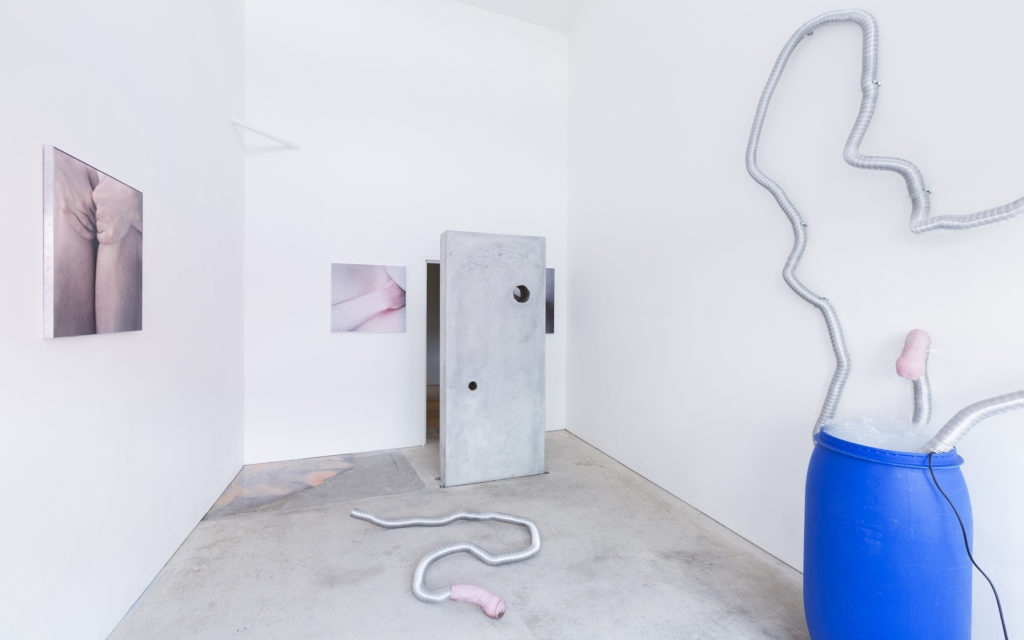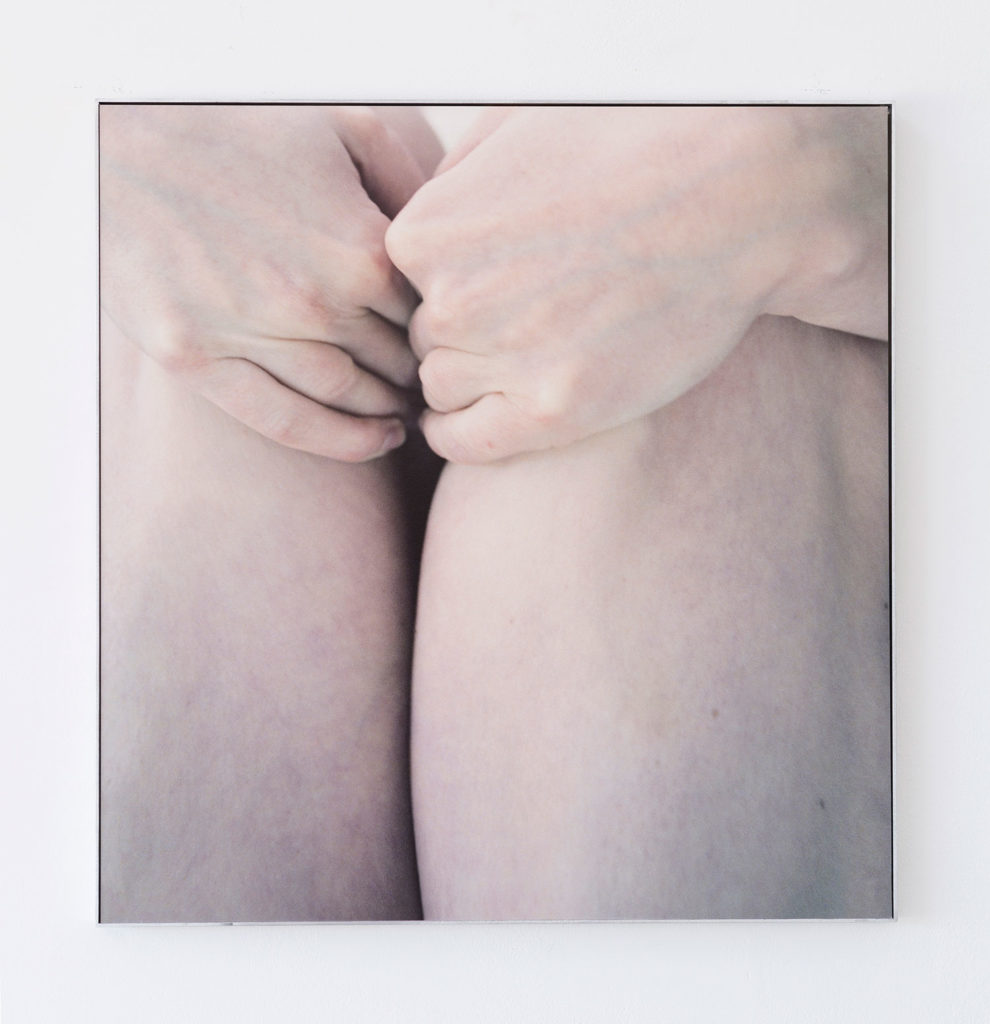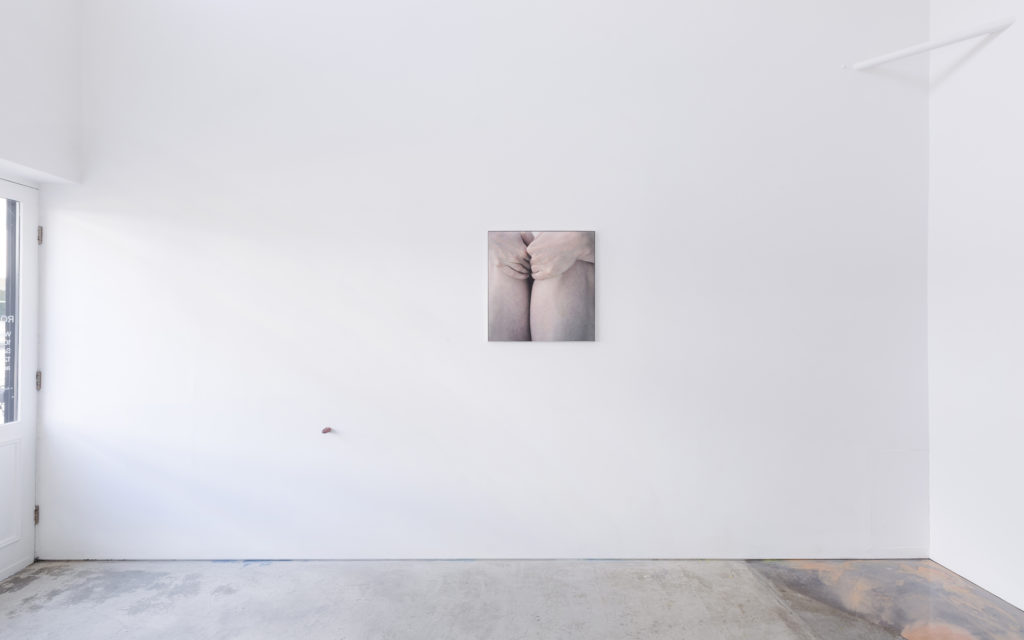Are we losing touch with ourselves the more we engage with technology and immerse ourselves in the urban environment around us? Do we feel dependence, an attachment to our phones? Can we talk of iPhones as prosthesis, an extension of the self, in the phenomenological sense? According to Maurice-Marcel Ponty – who is often regarded as the father of phenomenology, the strand of philosophy concerned with embodiment and experience, or ‘being-in-the-world’ – we repeat certain behaviours over and over again until they become habitual. Thus the repeated action of checking our mobile phones before we go to bed every night causes the mobile phone to become a part of us, ingrained into our being, part of our corporeality. Our urban landscape has therefore punctured the boundaries of our bodies, and this loss of a coherent body is the main theme underpinning MDAM, a joint exhibition at Roman Road by two recent Royal College of Art Photography graduates – Mia Dudek, a London-based Polish artist, and Alix Marie, a French artist working in London. The title of their exhibition is an anagram of their names and a subtle nod to the gendered undertones peppering their works.
Entering the shoebox gallery on Roman Road I am confronted by Dudek’s monolithic concrete slab consigned to the far end of the compact space. Circling it on the walls are her photographic works – large-scale macro frames of the female nude. These pieces are in dialogue with Marie’s playful phallic sculptures, which are dotted around the front and centre of the space, demanding attention. Any notion of a fixed, stable body is discarded, as both artists demonstrate various methods of remodelling the physical body in relation to its urban setting.
Dudek investigates a detachment with corporeality through techniques of fragmentation and distortion, which permeate her photographic works. Rather than portraying it in a singular shot, Dudek’s female nude is severed into three close-ups (Casing I & II, 2017 and Casing III, 2017), forming a patchy triptych contesting recognisable depictions of the body image. Every photograph is coated in steely-cool undertones underlining the translucent and porous properties of the human skin. Dudek’s photographs are sensual – you can discern the delicate veins jutting out of the receptive surface, the gradients of warmth and discolouration. You can almost knead the supple elasticity of the skin. These familiar forms are however violated into new assemblages of skin-concrete-metal, merging with materials characteristic of the urban environment.
Any notion of bodily composure is further ruptured in Body Recast IV (2017) – a pool of murky brown silicone and colour pigments seeping from the far left corner of the room. Borders between the human body and synthetic matter blur. Contemporary academic writing on affect – the study of emotion – speculates that bodies are what sociologist Lisa Blackman calls in her book Immaterial Bodies (2012) “processes which extend into and are immersed in worlds.” Dudek’s photographs indicate the breaking down of boundaries between the human body and the urban environment, the malleability of physical borders.

Mia Dudek and Alix Marie: MDAM, installation view, Roman Road, London, 27 April – 26 May 2017. Courtesy of Roman Road and the artists. © Ollie Hammick
The centrepiece of the room exemplifies this questioning of corporeality. Body Recast III (2017) is a mammoth rectangular mass of concrete and wax. Measuring 210 x 90 x 23 cm it dwarfs the space with its arresting physicality. Once again the notion of a contained body is disputed by the two incongruous holes, which puncture the artwork. Odd and out of place, these orifices do not only interrupt the physiological structure of the piece but by resembling ‘glory holes’ – holes seen most often in public cubicles to aid sex between strangers – hint at the mechanisation of sex in society. Dudek’s work is a mirror onto the era we live in, where our bodies are constantly modified through social media filters and our sexual needs can be readily addressed through mobile apps like Tinder. Our bodies are not our sole property, but are rather shaped by technology; the borders between technology and us blur, forming what Blackman calls new ‘brain-body-world entanglements’.
These new entanglements are conceived in Marie’s Greco-Roman influenced phallic sculptures. Lilith (2017) reinterprets the classical water fountain as a functional vent, formed from a waste barrel pumping a wetting agent through an aluminium ducting. Throughout evening this wetting agent grows into a foam tower spilling out from its fixed borders, hinting at a humorous violation of bodily composure, how volatile are bodily boundaries are. Stretched over the end of the ducting is a flesh light, a sex toy fashioned to imitate a vagina. Through attaching these sex toys onto industrial materials, Marie emphasises their crude functionality, and the merging of bodies with synthetic apparatus.
In the centre of the room an aluminium snake rattles and buzzes on the gallery floor. Eve (2017) is another metal ducting reincarnation, with a flesh light and vibrator strapped to its body. I stare transfixed at this personified sculpture; the whirring drone emitting from its metallic shell makes its presence impossible to ignore. This is not the romanticised biblical Eve in the Garden of Eden, but a clinical reduction of female anatomy. It begs the question of whether technology has made us lose touch with the sensual world too.
It is unclear where the boundaries of the body end and where they begin in MDAM. Dudek’s and Marie’s works harmonise to the extent that they cloud differences between them, merging to form new hybrid bodies of concrete, aluminium, rubber and wax. We can no longer speak of ourselves detached from our surroundings; in fact, we are completely composed of the world around us.

Mia Dudek, Casing III, 2017. Giclée archival print (Hahnemühle Baryta), 67 x 65 cm (68 x 66 cm with frame), edition of 5. Courtesy of Roman Road and the artist. © Ollie Hammick

Alix Marie, Pharmacopornographic Relic, 2017. Concrete cast of double dildo with salt crystals in glass aquarium, 25 x 25 x 25 cm, unique. Courtesy of Roman Road and the artist. © Ollie Hammick

Mia Dudek and Alix Marie: MDAM, installation view, Roman Road, London, 27 April – 26 May 2017. Courtesy of Roman Road and the artists. © Ollie Hammick








